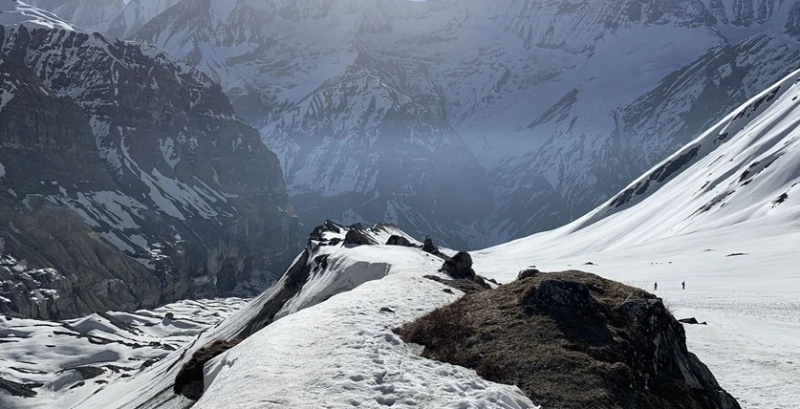Are you ready for an unforgettable adventure in the Himalayas? Look no further than the Annapurna Base Camp (ABC) trek. This renowned trek offers stunning landscapes, cultural experiences, and breathtaking views of the Annapurna Massif. In this comprehensive guide, we will provide you with all the information you need to know to embark on this incredible journey.
Trek Overview
The Annapurna Base Camp trek is an 9-day adventure that covers approximately 95 kilometers. The trek begins and ends in Kathmandu, with a scenic drive to Pokhara, the gateway to the Annapurna region. From Pokhara, you'll head to Nayapul, the starting point of the trek. Throughout the trek, you'll experience a maximum altitude of 13,549 feet (4,130 meters) at the Base Camp itself.
Preparation
Before embarking on the ABC trek, it's important to prepare yourself physically and mentally. While the trek is rated as moderate-plus difficulty, it still requires good physical fitness and prior high-altitude trekking experience. Make sure to engage in a pre-trek exercise regimen to strengthen your body for the challenges ahead. Additionally, pack all the essential items such as trekking gear, appropriate clothing, toiletries, and a reliable pair of trekking shoes.
Permits
To trek to Annapurna Base Camp, you'll need to obtain the necessary permits. Foreigners are required to have a park permit, which costs 2,000 NPR, and a TIMS (Trekkers' Information Management System) permit. SAARC nationals, including Indians, enjoy a reduced permit price of 200 NPR. These permits can be obtained at the Nepal Tourism Board Office in Kathmandu or through a tour operator.
Solo or Group Trek?
The ABC trek offers the flexibility to trek solo or with a group. The trail is well-marked, and there are teahouses along the way that provide accommodation and meals. If you choose to trek solo, ensure you have sufficient knowledge about the route, villages, and campsite basics. However, if you prefer a more organized experience, joining a trekking group led by a reputable tour operator can provide added safety, guidance, and assistance with permits and lodging arrangements.
The Trail and Views
The Annapurna Base Camp trek offers a diverse and awe-inspiring trail. As you trek through lush forests, cross suspension bridges adorned with prayer flags, and pass through charming Nepali villages, you'll be surrounded by the beauty of the Himalayas. Once you reach higher elevations, you'll be rewarded with panoramic views of snow-capped peaks, including Machhapuchhre, Annapurna South, Annapurna III, Annapurna I, Gangapurna, and Hiunchuli.
Accommodation and Teahouses
Throughout the trek, you'll find teahouses offering comfortable lodging and delicious meals. These teahouses are run by friendly locals who provide a warm welcome to trekkers. Staying in teahouses eliminates the need to carry extensive camping equipment and food supplies, making the trek more accessible for solo trekkers. However, it's advisable to book your accommodations in advance during the peak trekking seasons to ensure availability.
Weather and Best Time to Trek
The weather in the Annapurna region varies depending on the season. The best time to trek to Annapurna Base Camp is during the spring (March to May) and autumn (September to November) seasons. These months offer stable weather conditions, clear mountain views, and comfortable temperatures for trekking. However, it's essential to be prepared for changes in weather, especially at higher altitudes, where temperatures can drop significantly.
Altitude Sickness and Acclimatization
Altitude sickness is a potential risk when trekking to higher elevations. It's crucial to acclimatize properly to minimize the chances of experiencing altitude-related illnesses. The ABC trek provides several acclimatization days at strategic points along the route. These rest days allow your body to adjust to the increasing altitude gradually. It's recommended to stay hydrated, maintain a steady pace, and listen to your body's signals to ensure a safe and enjoyable trek.
Safety and Emergency Services
While trekking, safety should always be a top priority. It's essential to have travel insurance that covers high-altitude trekking and emergency evacuations. Carry a comprehensive first aid kit, including medications for common ailments and any personal medications you may require. Additionally, familiarize yourself with the emergency services available in the region and inform your trekking guide or teahouse owner if you experience any health issues during the trek.
Cultural Experiences and Local Hospitality
Trekking to Annapurna Base Camp offers not only natural beauty but also cultural immersion. Along the trail, you'll encounter local communities and have the opportunity to learn about Nepali culture and traditions. Interact with the friendly locals, taste traditional Nepali cuisine, and gain insight into the daily lives of the people living in the mountains. Embrace the warm hospitality of the Nepali people and create lasting memories of your trek.
Packing List
To ensure a comfortable and successful trek, here's a comprehensive packing list for the Annapurna Base Camp trek:
· Rucksack bag with rain cover
· Day pack bag (recommended for summit day)
· Head torch with spare batteries
· U.V. protection sunglasses
· Water bottles (2 bottles of 1 liter each)
· Non-skid, deep-treaded, high-ankle trekking shoes
· Pair of lightweight slippers/sandals
· Quick-dry warm lower or track pants
· Full-sleeve t-shirts/sweatshirts
· Pair of thick woolen socks
· Thermal body warmer upper & lower
· Undergarments
· Warm jacket closed at wrist & neck
· Full-sleeve sweater
· Rainwear (jacket & pants)
· Pair of waterproof, warm gloves
· Woolen cap
· Sunshielding hat
· Personal toiletries kit
· Sunscreen lotion
· Lip balm
· Small-size, lightweight, leak-proof lunch box
· Plate
· Spoon
· Tea/coffee (plastic) mug
· Camera (optional)
· Medications and first aid kit
· Dry fruits, nuts, and chocolate bars (optional)
Conclusion
Embarking on the Annapurna Base Camp trek is an adventure of a lifetime. From the stunning landscapes to the cultural experiences, this trek offers a perfect blend of natural beauty and local hospitality. Whether you choose to trek solo or with a group, proper preparation, acclimatization, and safety measures are essential for a successful journey. So pack your bags, lace up your trekking shoes, and get ready to explore the wonders of the Annapurna region on this unforgettable trek.
"The journey of a thousand miles begins with a single step." - Lao Tzu


